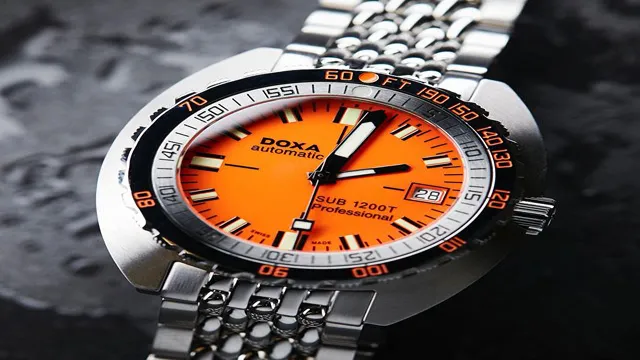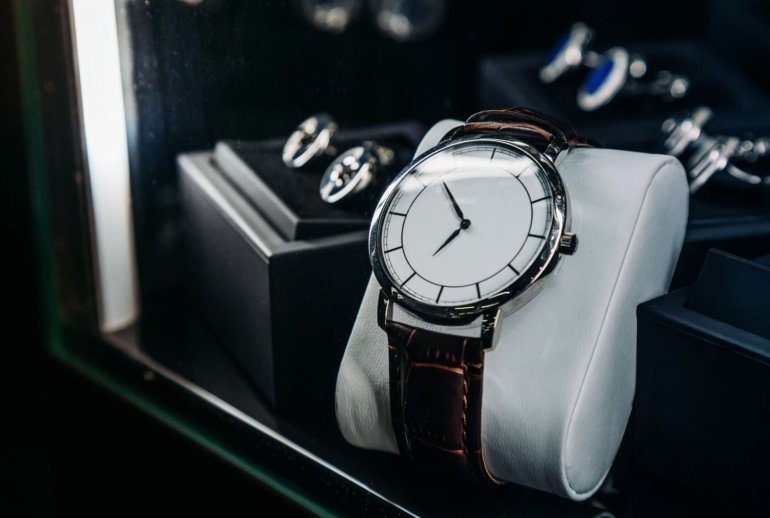When it comes to the world of wristwatches, few designs are as iconic as the dive watch. With their rugged construction, bold styling, and impressive functionality, dive watches have remained popular for professionals and enthusiasts. But where did this classic timepiece originate, and how has it evolved over time? In this blog post, we will deeply dive into the rich history of the dive watch, exploring its roots, innovations, and enduring appeal.
So, strap on your scuba gear and join us as we explore the fascinating world of dive watches!
Early Dive Watches
Dive watches have become a popular timepiece for both divers and non-divers alike. But where did the idea of a dive watch come from? In the early days of diving, divers had to rely on their timing skills to know when to surface. However, wristwatches were not waterproof and could not withstand deep water pressure.
The first true dive watch was invented in the 1950s by Rolex – the Submariner. This watch was designed for professional divers and was capable of withstanding depths of up to 100 meters. Since then, dive watches have become a staple for divers and watch enthusiasts.
Today, dive watches come in various styles with different features, such as water resistance, chronographs, and dive bezels. With their rugged durability and sleek style, it’s no wonder why dive watches have become such a popular accessory for both the diving community and everyday wear.
Rolex Submariner
The Rolex Submariner is one of the most recognizable dive watches in the world. However, its popularity did not happen overnight. The concept of dive watches began in the early 1900s when divers needed reliable, waterproof watches for underwater expeditions.
This led to the creation of the first water-resistant watches, such as the Omega Marine, in 193. However, it wasn’t until the 1950s that the first dive watches as we know them today were developed, with the Rolex Submariner being at the forefront of this innovation. The Submariner was designed with a unidirectional bezel, allowing divers to time their dives accurately and a high-visibility dial, making it easy to read in low-light situations.
Its ruggedness and reliability quickly made it a favourite among divers and watch enthusiasts. Today, the Rolex Submariner remains a classic and coveted timepiece that embodies the spirit of adventure and exploration.

Omega Seamaster
Early Omega Seamaster dive watches hold a special place in the hearts of watch enthusiasts. In the 1950s, the Seamaster model solidified Omega’s place in the dive watch market. These early models were expertly crafted with functionality in mind, boasting water resistance up to 200 meters.
The Seamaster’s classic design features a clean, sleek look with a rotating bezel and luminous markings for easy readability during dives. Omega’s dedication to precision and durability has made the Seamaster a beloved choice for divers and watch enthusiasts. Today, Omega continues to improve upon the already impressive Seamaster line, showcasing its ability to maintain a timeless design while incorporating cutting-edge technology.
In short, the Omega Seamaster represents a rich history of dive watch craftsmanship and a dedication to modern innovation.
Dive Watch Specifications
Dive watches have been around for quite some time and have been popular among divers and watch enthusiasts for their advanced specifications. The dive watch’s history dates back to the early 20th century when it was first introduced to aid military navy divers in underwater operations. Today, dive watches have evolved into specialized timepieces that withstand water pressure up to 1000 meters and extreme temperatures.
The popularity of dive watches comes from their robustness, legibility, and technical features, such as a unidirectional rotating bezel and a helium escape valve. They are not only tools for divers but also serve as fashionable accessories for those who appreciate dive watches’ rugged, sporty appearance. The versatility of dive watches has made them a fan favourite among watch collectors, making them a must-have in any watch collection.
Water Resistance Of Dive Watch
When it comes to purchasing a dive watch, water resistance is a crucial specification that many buyers look for. A dive watch’s water resistance rating tells us how deep the watch can withstand water pressure. The water resistance is typically indicated in depth, so the higher the listed depth, the more water-resistant the watch is.
However, it’s important to note that a watch’s water resistance does not guarantee that it will hold up in all water conditions. The watch’s water resistance can be affected by temperature, position, and even shock. It’s important to remember that even though a dive watch has a high water resistance rating and is designed for diving, it’s important to take extra care of it to ensure it continues functioning correctly.
Overall, when it comes to dive watches, water resistance should be a top priority for buyers to ensure their safety and protect their investment over time.
Bezel
When it comes to dive watches, the bezel is an essential component. The ring on the watch face rotates to help divers keep track of elapsed time while underwater. The bezel on a good dive watch should be unidirectional to prevent accidental adjustments during a dive.
It should also be easy to read, with clear markers and numbers to monitor the dive’s duration. Some dive watches come with a ceramic or sapphire crystal bezel insert for added durability, but others stick to traditional metals. A good bezel must be dependable and robust enough to withstand extensive use while diving, making it a vital part of any dive watch.
Luminescence
Luminescence When looking for a dive watch, there are some specifications to remember. First and foremost, it needs to be able to withstand water pressure at depth. But just as important is the watch’s luminescence.
It can be difficult to read a watch’s face underwater without enough light. Luminescence solves this problem by making the watch’s hands and hour markers glow in the dark. This allows divers to keep track of their time and air supply.
Some dive watches use tritium, a radioactive gas, to create luminescence that lasts for years without recharging. Others use Super Luminova, activated by light and can glow for several hours. Ultimately, the choice between these technologies comes down to personal preference and the specific needs of each diver.
As with any dive watch, it’s important to select one with reliable luminescence that will keep you safe during your time underwater.
Popularity of Dive Watches
Dive watches have existed since the 1950s when Rolex and Blancpain released versions designed specifically for divers. These watches had to be durable, water-resistant, and have a rotating bezel to measure elapsed dive time. Since then, dive watches have gained a loyal following from divers and watch enthusiasts alike.
There are many reasons why dive watches are so popular. For one, they are versatile and can be worn in various settings, from the ocean to the office. Additionally, dive watches are often designed to be durable and long-lasting, with many able to withstand extreme conditions.
Plus, the rotating bezel feature can come in handy for various activities, not just diving. Ultimately, the history of the dive watch and its popularity can be attributed to its unique design and functionality, making it a must-have for any watch enthusiast or diver.
Fashion Trend Of Dive Watch
Dive watches have become increasingly popular among fashion enthusiasts in recent years. Not only are they functional, but they also add a certain level of sophistication to any outfit. When it comes to dive watches, there are a variety of styles and brands to choose from.
Some popular options include the Rolex Submariner, the Omega Seamaster, and the Tudor Black Bay. These watches typically feature a durable and water-resistant design, making them perfect for avid divers or individuals who enjoy outdoor activities. Their versatility has also made them a go-to choice for everyday wear.
The popularity of dive watches can be attributed to their timeless design and the fact that they are a true icon in the world of horology. Whether you’re looking to make a statement or want a functional and stylish timepiece, a dive watch is a great choice that won’t go out of style any time soon.
Functional Use Of Dive Watch
The dive watch is one of the most recognizable and sought-after types of watches in the market today. This type of watch has gained immense popularity among divers, outdoor enthusiasts, and watch collectors alike for its functional use. Dive watches are built to withstand extreme conditions, like water pressure, cold temperatures, and harsh environments.
They typically have a unidirectional bezel, a luminescent dial, and a waterproof casing that can withstand depths of up to several hundred meters. Besides their practical use, dive watches have also become a style statement among the fashion-conscious. Many high-end watch brands, including Rolex, Omega, and Breitling, have released dive watches that have become synonymous with luxury and sophistication.
The popularity of dive watches shows no signs of slowing down, making it a must-have accessory for anyone who values functionality and style.
Future of Dive Watches
Dive watches have a rich history that dates back to the early days of diving. These watches were originally designed to help divers keep track of their time underwater, but they have also become a fashion statement. The popularity of dive watches can be attributed to their durability, accuracy, and style.
These watches are built to withstand the harsh conditions of deep-sea diving and are often water-resistant to depths of 200 to 1000 meters. Furthermore, dive watches come in a wide range of styles from classic to modern, making them a versatile accessory for any wardrobe. It’s no wonder that dive watches are a must-have for watch enthusiasts and divers alike.
So, if you’re looking for a timepiece that can stand the test of time both functionally and fashionably, investing in a high-quality dive watch might be the way to go.
Conclusion
In conclusion, the dive watch’s history is filled with innovation, exploration, and a little bit of daring. From humble beginnings as a tool for military divers, the dive watch has proven itself to be a reliable and stylish timepiece for adventurers and fashion enthusiasts alike. Its popularity can be attributed to its rugged and functional design and its association with the exciting and adrenaline-fueled world of underwater exploration.
So whether you’re a seasoned diver or just someone who appreciates a good watch, the dive watch is a classic choice that’s sure to make a splash.”
FAQs
When was the first dive watch invented?
The first dive watch was invented in 1926 by Rolex, called the Rolex Oyster.
Why are dive watches popular?
Dive watches are popular because of their durability, water resistance, and ability to function in extreme conditions. They are also stylish and versatile, making them suitable for both diving and everyday wear.
What features make a good dive watch?
A good dive watch should have a water resistance of at least 200 meters, a unidirectional bezel for tracking time and decompression stops, and high-visibility markings for reading time in low light conditions. It should also have a durable case construction and a reliable movement.
How have dive watches evolved over time?
Dive watches have evolved significantly over time with advancements in technology and materials. They have become more accurate, reliable, and feature-rich, with added functions such as depth gauges, helium release valves, and dive logs. Design-wise, they have become more stylish and versatile, with different color options, materials, and interchangeable straps.


